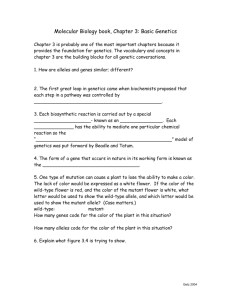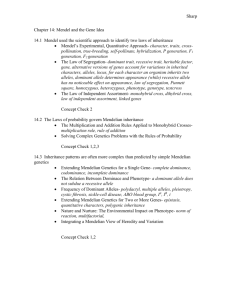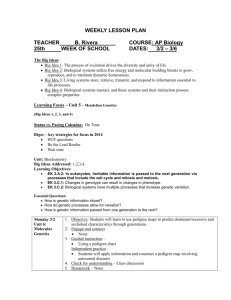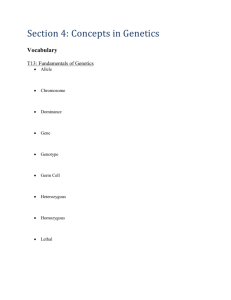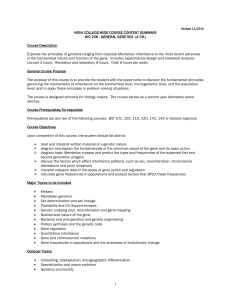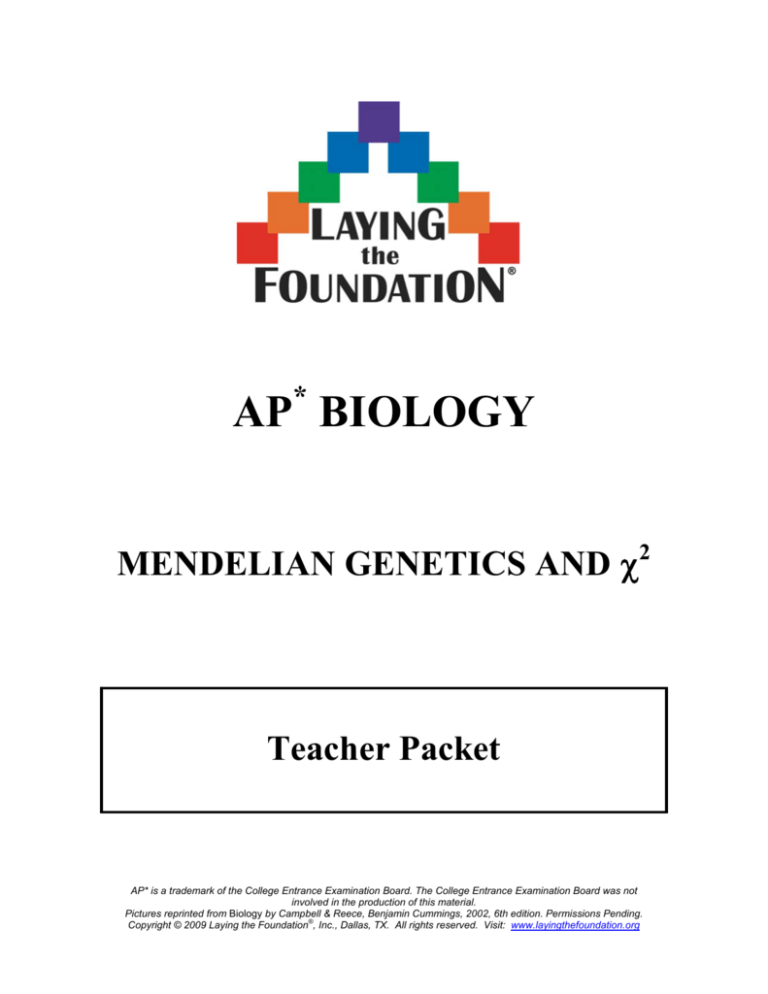
*
AP BIOLOGY
MENDELIAN GENETICS AND χ2
Teacher Packet
AP* is a trademark of the College Entrance Examination Board. The College Entrance Examination Board was not
involved in the production of this material.
Pictures reprinted from Biology by Campbell & Reece, Benjamin Cummings, 2002, 6th edition. Permissions Pending.
®
Copyright © 2009 Laying the Foundation , Inc., Dallas, TX. All rights reserved. Visit: www.layingthefoundation.org
Mendelian Genetics and χ2
Objective
To review the student on the concepts and processes necessary to successfully answer questions
over Mendelian genetics and chi square analysis problems.
Standards
Mendelian genetics and chi square analysis are addressed in the topic outline of the College
Board AP Biology Course Description Guide as described below.
II. Heredity & Evolution
A. Heredity
Meiosis and gametogenesis
Eukaryotic chromosomes
Inheritance patterns
B. Molecular Genetics
RNA and DNA structure and function
Gene regulation
Mutation
AP Biology Exam
Connections
Viral structure and replication
Nucleic acid technology and applications
The principles of are tested every year on the multiple choice and occasionally make up portions
of the free response section. There does seem to be an emphasis on sex linked inheritance and
linked genes in general based on released exam material. Mendelian crosses are asked on all
released multiple choice material that is currently available. The list below identifies free
response questions that have been previously asked over this topic. These questions are available
from the College Board and can be downloaded free of charge from AP Central
http://apcentral.collegeboard.com.
Free Response Questions
2003 Question #1
®
Copyright © 2009 Laying the Foundation , Inc., Dallas, TX. All rights reserved. Visit: www.layingthefoundation.org
Mendelian Genetics and χ2
Mendelian or Classical Genetics
Gregor Mendel is credited as the 1st to actually quantify
genetic crossing experiments.
Mendel’s Experimental Design
ÆUse pure strains (self fertilization)
ÆCross fertilize
ÆTrack data quantitatively (ratio is key)
Results
Æ The F1 generation displayed no blending of traits.
Æ F2 noticed some recessive traits re-emerged showing a
phenotypic ratio of 3:1. Note that the actual genotypic
ratio is 1:2:1 since recessive traits are present but masked.
Explanation?Æ According to F1 results one allele can
mask another allele. According to F2 results the masked
allele is not destroyed, but simply “dominated” by the
other.
Mendel’s Laws of Heredity
Law of Segregation
ÆAlleles don’t blend. One of two alleles is passed on in sex cells; probability or chance alone determines
which allele will be passed to the gamete. Punnett squares work because of this law.
Law of Independent Assortment
ÆEach pair of alleles segregates independently of other alleles.
®
Copyright © 2009 Laying the Foundation , Inc., Dallas, TX. All rights reserved. Visit: www.layingthefoundation.org
Mendelian Genetics and χ2
Mendel meets the modern genetic language…
The stand alone meanings of many words used
Gene Map
frequently in genetics often seem similar. The
following is a “relative” summary of the language of
genetics.
ÆParents transmit genes; genes combine to form a
trait (like purple or white). A chromosome is full of
genes found at loci (location of the gene) that can be
seen on a gene map. Each version of this gene is
called an allele (like “W” or “w”). A sexually
reproducing individual will receive one allele from
each parent. Based on the relationship of the alleles
inherited, a pair of alleles may be described as a
homozygous genotype or a heterozygous
genotype. Each allele does not destroy the other.
The dominant allele is the one that is the outwardly
expressed trait (phenotype) in a heterozygote and is
said to “mask” the recessive allele.
The significance of the test cross.
ÆSuppose that an individual shows a dominant
phenotype. How might one determine the genotype
of this individual as is could be homozygous
dominant or heterozygous? The individual could be
crossed with a homozygous recessive individual. If
an adequate sample size is present, and all
individuals in the F1 generation continue to display
the dominant phenotype it is highly likely that the
individual in question is homozygous dominant for
the trait of interest.
Note: The dominant allele is not always the most
common in a population (polydactylism).
Note: There are several genetic crosses that are
“non-Mendelian” and will be discussed shortly
®
Copyright © 2009 Laying the Foundation , Inc., Dallas, TX. All rights reserved. Visit: www.layingthefoundation.org
Mendelian Genetics and χ2
Exceptions to Mendelian Genetics
Codominance
Incomplete Dominance
ÆBoth traits are expressed simultaneously: A
ÆA Blending of traits: A homozygous white
homozygous white flower crossed with a
flower crossed with a homozygous red flower for
homozygous red flower would create a red and
example will create a pink heterozygote.
white flower.
Epistasis
ÆMany genes controlling one phenotype or the
gene at one locus controlling the expression of a
gene at another locus: Consider the biochemical
cascade AÆBÆCÆD. If a single mutation occurs
in A,B, or C, the product D will be effected.
Pleiotropy
ÆOne gene controlling many phenotypes
(essentially the opposite of epistasis): The agouti
gene in mice is linked to coat color, obesity, and
certain tumors.
Polygenic Inheritance
ÆMany genes controlling one phenotype with an
additive effect: Laborador Retreiver colors are
polygenic
AABBCC = Black Lab
AaBbCc = Lighter
Aabbcc= Lightest
Multiple Alleles
ÆMore than 2 alleles controlling one trait and
therefore more than a simple dominant/recessive
relationship between alleles: Blood types are the
most common example of multiple alleles. Both A
and B are dominant while O is treated as recessive.
*Comparatively, epistasis is more like a moving
assembly line where each gene is dependent on the
next.
Type A = IAIA or IAi
Type B = IB IB or IBi
Type AB = IA IB
Type O = ii
Sex linked traits
Environmental Effects
ÆThe genes of interest are located on the sex
ÆEnvironmental cues give to rise to modifications
chromosomes. Sex linked traits are carried on the
in phenotype: The coat of the arctic fox changes
X chromosome as no genes shared by both male
from white to earthy brown as the temperature rises
and female can be carried on the Y chromosome.
due to a color related enzyme. The fox benefits
Hemophilia is common example on the AP exam.
from this well timed camouflage.
Chromosomal Alterations
Deletion
Æremoval of a chromosomal segment
Duplication
Æ repetition of a chromosomal segment
Inversion
Æ reversal of a chromosomal segment
Translocation
ÆMovement of a chromosomal segment
from one chromosome to another
nonhomologous chromosome. Crossing
over (meiosis) by contrast occurs
between homologous chromosomes.
Reciprocal translocation means that
chromosomal material is traded (give and
receive).
®
Copyright © 2009 Laying the Foundation , Inc., Dallas, TX. All rights reserved. Visit: www.layingthefoundation.org
Mendelian Genetics and χ2
Genetic Maps, Linked Genes, & Recombination
Recombination
ÆRecombination through crossing over occurs during prophase of meiosis I. Since crossover is random,
the likelihood that 2 genes crossover increases as the distance between those 2 genes increases since there
are more points between them where crossover may occur. The unit of measure of this distance is the
map unit.
Gene Linkage Maps
ÆUsing crossover frequencies one can construct a linkage map to visually represent the relative distances
between genes.
Linked Genes
ÆGenes that are close together are said to be linked as they often “travel together” during crossing over.
Gene Linkage Example Problem:
Reconstruct the order of the gene map based on the recombination frequencies listed below.
GENE
A-C
B-C
B-D
A-D
®
CROSSOVER
FREQUENCY
30%
45%
40%
25%
Copyright © 2009 Laying the Foundation , Inc., Dallas, TX. All rights reserved. Visit: www.layingthefoundation.org
Mendelian Genetics and χ2
1. It is usually most efficient to begin with the genes that are farthest apart.
2. Next, begin overlapping genes. It is sometimes more productive to attempt to pick
internal genes first.
3. Remember that crossover frequencies cannot exceed 50%
B------------------45------------------C
insert the possibilities for D
D-------------40--------------B-----------------40-------------D---C (could go either way)
blindly choose B-D-C over D-B-C
B-----------------40-------------D----C
insert A and deduce map distances to match the table
B-----15----A--------25--------D--5-C
Correct Answer: BADC
®
Copyright © 2009 Laying the Foundation , Inc., Dallas, TX. All rights reserved. Visit: www.layingthefoundation.org
Mendelian Genetics and χ2
χ 2 Chi Square Analysis
What’s the point?
ÆIf a person were to flip a coin 100 times. How many heads and how many tails should he get?...50
heads and 50 tails. Suppose that he got 51 heads and 49 tails….did he just disprove probability? What
about 55:45? What about 60:40? At what point does one conclude that the coin is likely abnormal or that
some other aspect of the experiment is likely askew? Chi Square to the rescue! Chi square determines
whether or not results seem to confirm or call into question a hypothesis.
χ 2 = ∑ ( Fo − Fe ) F
e
Null Hypothesis vs. Alternative Hypothesis
ÆNull: no statistically significant difference
between expected and observed results
ÆAlternative: explanation (hypothesis) of why
the results are so different from what’s expected
How to use the information.
ÆCompare χ 2 results to the χ 2 table. From this
information, one can determine with a specified
amount of certainty that the data is legitimate.
Æ Probability values: P values measure from 0 1. P = 1 is perfectly expected data (like 50 heads
and 50 tails) meaning that we accept our null
hypothesis. P = 0 is completely unexpected data
(like 100 heads and 0 tails OR 0 heads and 100
tails) and we should create an alternative
hypothesis. Most data will fall somewhere in
between. In “life science circles”, it is accepted
that a P value of 0.05 or higher is considered
acceptable.
ÆDegrees of Freedom: DF represents the
number of alternate possibilities. In other words,
total possibilities-1. In our coin example we can
get heads or tails, so we have 2 possibilities – 1 =
1 degree of freedom. If we were looking at a 6
sided die, we would have 6 - 1 = 5 degrees of
freedom.
®
2
Fe = Frequency expected
Fo = Frequency observed
χ 2 critical values
df
1
2
3
4
.995
.000
.010
.072
.207
probability
.90
.50
.10
.016 .455 2.706
.211 1.386 4.605
.584 2.366 6.251
1.064 3.357 7.779
.05
3.841
5.991
7.815
9.488
.025
5.024
7.378
9.348
11.143
*Line up the predetermined acceptable P value with
the appropriate number of degrees of freedom. If
your chi square value is less than this number,
accept the null hypothesis. If the chi square value is
greater than or equal to this number, the null
hypothesis must be rejected and an alternative
hypothesis must be created.
Copyright © 2009 Laying the Foundation , Inc., Dallas, TX. All rights reserved. Visit: www.layingthefoundation.org
Mendelian Genetics and χ2
χ 2 Example Problem:
From a cross between two plants, one completely heterogyzous tall green (SsYy) and the other
heterozygous tall yellow (Ssyy), the following results were observed:
52 tall green
55 tall yellow
26 short green
27 short yellow
A. Show by Punnett square (or other labeled diagrams) the cross between the two original plants and
the expected phenotypic ratio of offspring.
B. Use χ 2 calculations to determine whether or not the variations in the observed results could be
due to chance.
1) Set up the problem to determine the expected ratio:
SsYy x Ssyy
Show possible gametes from each parent: SsYy can produce SY, Sy, sY, and sy
Ssyy can produce Sy and sy
The Punnett square should be 4 x 2 with the following phenotypic ratio:
Sy
sy
SY
SSYy
SsYy
Sy
SSyy
Ssyy
sY
SsYy
ssYy
sy
Ssyy
ssyy
Expected ratio: 3 tall green, 3 tall yellow, 1 short green, 1 short yellow
USING THE OBSERVED RESULTS, DETERMINE WHAT WAS WOULD BE EXPECTED
FROM THE 3:3:1:1 RATIO (Hint: 3:3:1:1 is actually 8 parts)
Total the results and divide by 8 to determine what one part would be.
160/8 = 20
Three parts would be 3(20) = 60.
Therefore, the EXPECTED results from the cross would be 60:60:20:20.
You already have the observed results.
X2 = (52 - 60)2 + (55 - 60)2 + (26 – 20)2 + (27 – 20)2 = 64 + 25 + (3)36 + (3)49 = 334 = 5.73
60
60
20
20
60
60
Degrees of freedom = 3
Critical value (from chi-square table) = 7.815
Conclusion: 5.73 is less than 7.815 and within the limits of chance; therefore, the observed
results could fit the 3:3:1:1 ratio.
®
Copyright © 2009 Laying the Foundation , Inc., Dallas, TX. All rights reserved. Visit: www.layingthefoundation.org
Mendelian Genetics and χ2
Multiple Choice
1. Genes S and T are not linked. If there is a 50% probability that allele S is in a gamete and there is a
50% probability that allele T is in a gamete, what is the probability that both are in the same gamete?
(A) 5%
(B) 25%
(C) 50%
(D) 75%
(E) 100%
B
There is a 25% chance that S and T will both be found in the same gamete.
(.5)(.5) = .25
2. The trait for tall pea plants is (T) and the trait for short pea plants is (t). The trait for smooth peas is
(S) and the trait for wrinkled is (s). Two plants are crossed yielding an F1 generation with 612 tall
plants with smooth peas and 188 short plants with wrinkled peas. Which of the following is the most
likely genotype of the parent generation?
(A) ttss x ttss
(B) TTss x TTss
(C) TtSs x TtSs
(D) TTSS x ttss
(E) TtSS x Ttss
C
The F1 generation represents ~ 3:1 ratio typical of heterozygote crosses. TtSs
crossed with TtSs will give a 3:1 ratio.
3. A male and female have 3 offspring all of which are female. The couple is now pregnant again.
What is the likelihood that the next child will be a female?
(A) 1/16
(B) ¼
(C) 1/3
(D) ½
(E) ¾
D
Each birth is independent of the previous birth. There is always a 50% chance
that the next individual birth will be a female. Be careful!- see next question
4. What is the likelihood that a couple will have 4 offspring all of which are female?
(A) 1/16
(B) ¼
(C) 1/3
(D) ½
(E) ¾
A
Each individual birth represents a ½ chance of producing a female. The
likelihood that four consecutive births will all be female is (½)4 or 1/16.
®
Copyright © 2009 Laying the Foundation , Inc., Dallas, TX. All rights reserved. Visit: www.layingthefoundation.org
Mendelian Genetics and χ2
5. A child is born with the blood type B. The mother of the child is blood type O. Which of the
following statements is most correct?
(A) The father must be type B
(B) The father could be type AB
(C) The father passed along a recessive allele
(D) The mother could have passed along a type B allele
(E) The mother could have passed along a dominant allele
B
The child received a recessive i allele from his mother as she is ii. This is a
recessive allele. The father could be type B but could also be type AB. In
this case only answer choice that is feasible is choice B.
6. If traits X, Y, and Z are consistently inherited together, which of the following best explains why this
is the case?
(A) These 3 traits are all dominant.
(B) The parents both carry the dominant form of each trait.
(C) These 3 traits are located on different chromosomes
(D) These 3 traits are located close to each other on the same chromosome.
(E) These 3 traits are located far from each other on the same chromosome.
D
The genes that code for these traits appear to be linked. Linked genes are
located near one another on the same chromosome so that they are not often
separated during the process of crossing over in meiosis. The closer they are
to each other, the less likely they are to separate. Dominance is irrelevant in
this scenario.
7. Hemophilia is a sex-linked recessive trait. A male hemophiliac and phenotypically normal female
have a girl that is a hemophiliac. All of the following statements are correct EXCEPT:
(A) The daughter inherited a recessive gene from each parent.
(B) The daughter inherited a dominant allele from her mother.
(C) The mother is a carrier of hemophilia
(D) The genotype of the mother is XH Xh
(E) The genotype of the father is XhY
B
The daughter did not inherit a dominant allele from her mother. If this were
the case the daughter would not be a hemophiliac. All other statements are
true.
®
Copyright © 2009 Laying the Foundation , Inc., Dallas, TX. All rights reserved. Visit: www.layingthefoundation.org
Mendelian Genetics and χ2
Questions 8-10 refer to the following genetic terms
(A) Codominance
(B) Epistasis
(C) Multiple alleles
(D) Pleitotropy
(E) Incomplete Dominance
8. A red flower and a white flower produce a pink flower
E
Incomplete dominance shows as a phenotypic blending of traits.
9. A red flower and a white flower produce a red and white streaked flower
A
In codominant inheritance both alleles are expressed.
10. A single gene coding for multiple phenotypes
D
Pleiotropy is when a single gene codes for multiple phenotypes.
®
Copyright © 2009 Laying the Foundation , Inc., Dallas, TX. All rights reserved. Visit: www.layingthefoundation.org
Mendelian Genetics and χ2
Free Response
1. Imagine an isolated species of caterpillars with five distinct color variations living in a prescribed area.
Many counts of these caterpillars revealed that the colors were equally balanced. In July a count of
50caterpillars revealed:
10 green
10 yellow
10 brown
10 white
10 red
Also in July a species of bird that preys on caterpillars was introduced in the area of the caterpillar
population. After two months the caterpillar population had dropped, and when the count was done, the
color variations were no longer balanced. The following results were obtained from a random count of 25
caterpillars in early September:
10 green
5 yellow
7 brown
1 white
2 red
A. Using chi-square, determine if the color variations found in the September count could be due to
chance, or if some other factor influenced results.
χ 2 critical values
df
1
2
3
4
.995
.000
.010
.072
.207
.90
.016
.211
.584
1.064
probability
.50
.10
.455 2.706
1.386 4.605
2.366 6.251
3.357 7.779
.05
3.841
5.991
7.815
9.488
.025
5.024
7.378
9.348
11.143
1 pt for each of the following
Mathematics
_original ratio is 1:1:1:1:1
_choosing 5 as the correct expected value for each color OR showing such mathematically
_using the correct observed values for all 5 colors in the chi square equation
_correct answer of 10.8 or rounded value of ~11
X2 = (10 - 5)2 + (5 - 5)2 + (7 - 5)2 + (1 - 5)2 + (2 - 5)2 = 54 = 10.8
5
5
5
5
5
5
Data Interpretation
_the critical value at 0.05 is 9.49
_there are 4 degrees of freedom.
_the number is greater than the critical value AND that this means the results are not due to chance
®
Copyright © 2009 Laying the Foundation , Inc., Dallas, TX. All rights reserved. Visit: www.layingthefoundation.org
Mendelian Genetics and χ2
B. What was the most likely influence in the results revealed in the September count?
1 pt for each of the following
_birds fed more frequently on caterpillars with conspicuous colors
_camouflaged caterpillars are not as easily detected by the birds and therefore avoided consumption
C. Propose a possibility of what may happen to the caterpillar color variations if the birds and
caterpillars remain in the area for five years and explain the biological significance of this
outcome.
1 pt for each of the following
_Populations will shift such that the vast majority of caterpillars will be green or brown OR the yellow,
white, and red colors will become increasingly rare in the population
_Adaptations such as camouflaging colors provide an advantage to the caterpillars
®
Copyright © 2009 Laying the Foundation , Inc., Dallas, TX. All rights reserved. Visit: www.layingthefoundation.org
Mendelian Genetics and χ2
Free Response
2. Chromosomal alterations can have significant evolutionary impact.
A. Observe the collected recombination data below. Recent experiments show that gene C is more
closely linked with D than with A. Reconstruct a gene map and determine the map distance
between C and D.
GENE CROSSOVER
FREQUENCY
A-B
7%
A-C
18%
C-D
?
B-D
35%
1 pt for each of the following
_gene map order is BACD
_map distance between C and D is 10 map units
B. Discuss the events involved in crossing over during meiosis and describe the evolutionary
significance of this event.
1 pt for each of the following
_synapsis is the process of bringing together homologous chromosomes during prophase of
meiosis I
_crossing over occurs when genetic material is exchanged between homologous chromosomes
_crossing over produces genetic variation
_genetic variation allows for a mixture of adaptations that may prove beneficial for the survival
of an organism.
®
Copyright © 2009 Laying the Foundation , Inc., Dallas, TX. All rights reserved. Visit: www.layingthefoundation.org
Mendelian Genetics and χ2
C. Describe 2 of the following 4 chromosomal alterations. In light of evolution, are individual
alterations such as these beneficial or detrimental? Include a hypothetical or literal example in
your answer
Deletion
Duplication
Inversion
Translocation
1 pt for each of the following
Chromosomal Alteration
2 pt max
_Deletion is the removal of a chromosomal segment
_Duplication is the repetition of a chromosomal segment
_Inversion is the reversal of a chromosomal segment
_Translocation is the movement of a chromosomal segment from one chromosome to another
nonhomologous chromosome.
Evolution
_genetic diversity on the whole is beneficial to the population as it increases likelihood of
survival of the population
_a genetic alteration could be harmful, neutral, or beneficial.
_additional point for a sensible example of a situation in which the alteration is beneficial,
neutral, or beneficial
®
Copyright © 2009 Laying the Foundation , Inc., Dallas, TX. All rights reserved. Visit: www.layingthefoundation.org

